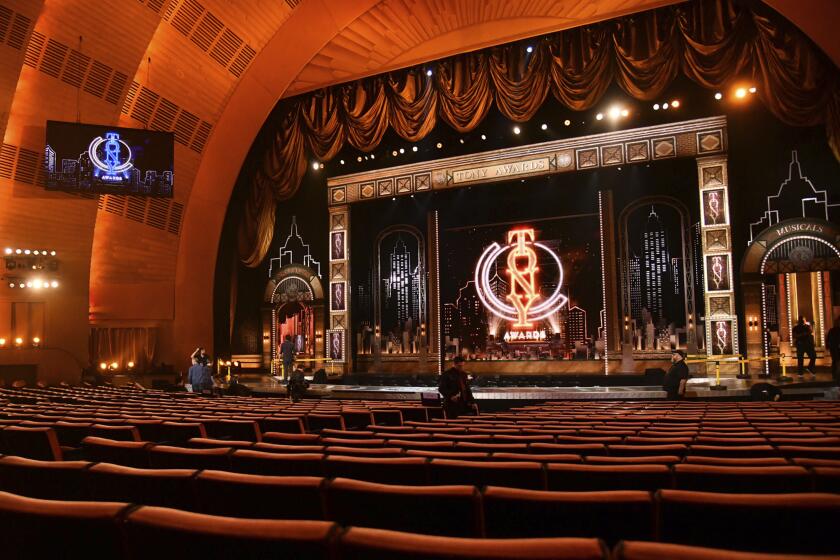ART REVIEW : Big Look at Orange County’s Best Falls Short of the Mark
- Share via
Every corner of the world has to have its favorite sons and home-grown geniuses. Naming them is a natural way of proclaiming that you are not just a dot on a map--you are a thriving center of civilization.
In the Year of the Centennial, it was inevitable that Orange County arts professionals would be asked to come up with a super-list of Orange County artists especially worthy of recognition. Sure enough, the Laguna Art Museum issued the call to five people who teach (or have taught) studio art or art history at the college level. All they had to do was prepare a list of names and alternates--no sweat, folks--and curator Michael McManus would trundle over to the studios and choose the works for the exhibit.
Of course, what everyone wants to know is who chose whom and why. What do these artists and instructors think of the local art scene? What are its strengths and weaknesses? Where is it headed? Surely all the jurors would contribute thoughtful essays on the subject.
As it turned out, a number of jurors didn’t want to reveal their choices. Too much politics involved there. So viewers of the Orange County Invitational exhibit, which runs through Jan. 15 at the Laguna Art Museum, get only a list of jurors’ names painted on a gallery wall and an undifferentiated sampling of the art of 30 people who live, work and/or teach in the county. No essays, no points of view at all. (And no information on the backgrounds of these artists, who range from “veterans” to recent graduates.)
True, many picks turned out to be identical, according to McManus. But it would have been valuable to see how different people with a broad knowledge of art evaluate the same artist. (The jurors were Dextra Frankel of Cal State Fullerton, Gene Isaacson of Rancho Santiago College, John Upton and Donna Sharkey of Orange Coast College, Melinda Wortz of UC Irvine and painter Vic Smith.)
Human nature being what it is, we’re also curious about which choices were A-list and which were alternates. And we wish we were looking at the jurors’ choice of works--presumably substantiating the reasons the artists were chosen--not somebody else’s.
What with all the styles flying around these days, and the diverse backgrounds and training of the artists chosen for the exhibit, it would be strange if this group had a single approach or a common point of view. But there is one factor that binds a number of the artists: a concern for the great outdoors as something increasingly rare and necessary to preserve.
Unfortunately, despite the worthiness of the concern, most of the art reflecting the theme comes across as well-meaning but essentially uninspiring.
Don Hendricks’ three-part piece, “No More Children of the Desolate,” sandwiches a painting of a scrubby landscape without a single sign of life between painted images of a dead bird whose body is partially nibbled away and of the jawbone of another animal. The message is clear, the anatomical detailing meticulous--and the Sierra Club would probably love it. But the whole thing is so flat-footedly obvious.
Tom Holste draws “portraits” of rocks that sit on the gallery floor as if inviting the viewer to compare the real thing to the artist’s rendering. Somehow, though, the rocks look like they are holding down the carpet rather than working as part of an installation piece. Rethought as part of a larger whole, these pieces might be a lot richer and clearer.
Kyoko Asano is admired in some quarters for her low-key, detailed paintings of beach detritus (soft drink cans, cigarette butts and so forth). In “Tree,” the faint outline of a tree rises against the sky, above pale bits of garbage. Pitting the strength and glory of nature against the depredations of piggy human beings is surely a worthy enterprise, but there is something hackneyed about this attempt that doesn’t rise above its good intentions.
One “nature” painting with no observable ax to grind is Robert Partin’s “Humboldt,” a small, abstract work with a vertically oriented melding of greens, blues and browns pierced by a white “vein.” Partin’s other work, in pastel and colored pencil, shares the same quietly assertive light-struck lyricism.
An installation called “Tree Rune (Moving in Amber at the Speed of Sound),” by Suvan Geer, a free-lance art reviewer for The Times, is another bright spot in the show. Mounted on a bright yellow “carpet” of ground corn, a motorized pointer moves briskly in a circle. Above it, a large tree root is suspended. Around it, curving sheets of paper mask the gallery walls and filter beams of light into a soft glow. The viewer can hear a steady whistling and a sound that brings to mind small things tumbling in a container.
Clearly, this is more than a sensory treat--though, like all runes (mystical poems), its meaning is obscure. The dead tree bulks over the space, lit so as to cast a shadow over the proceedings. The speeding pointer conveys a sense of urgency, and the mechanical sounds seem quietly relentless, possibly threatening. Perhaps the reference is environmental: Time is running out for the life of this tree, for the life of this planet.
The other installation in the show, Angie Bray’s “Grounded: With No Mind to Walk Through Walls,” is even more mysterious. Enveloped in darkness, the piece seems at first not to exist at all. Groping your way to a bench, you hear chanting and drumbeats.
Finally, when your eyes accustom themselves to the very low light level, the walls pop into focus, rimmed in white. But they are fake walls, cutting with transparent insouciance through the right-angled space of real rooms to make their own floating reality. There is also a small mound of something indistinguishable sitting on the floor.
Mesmerized by the chanting, I began associating the little mound with an Indian burial ground and wondered whether the illusory walls were some sort of mind trip for those whose religious drug of choice is peyote.
Well, let’s go back to the title. Grounded? With no mind to walk through walls? Oh, maybe the point is that we are stuck here in blah-de-dah reality, our minds stuck in ruts and unable to drift off into fruitful fantasy. Despite the added element of sound, however, this piece doesn’t seem as richly allusive as the one Bray did last summer at BC Space in Laguna Beach.
Other worthy pieces in the show are pretty much one of a kind.
Duncan Simcoe’s mixed-media adventures are a treat, especially “Song No. One,” with its breezy Southern California outdoor setting; its vivacious, painterly nude in a cheerfully retrograde Bay Area Figurative style, and its silly love poem (“ . . . Your stature is like a palm tree and your breasts are like its fruit”), painted, for some inscrutable reason, on an architectural drawing.
Frank Dixon’s lushly rendered satirical painting style has never looked better than in “Black Tie,” wherein images of smartly clad John and Robert Kennedy face off over the eerie, fragmented head of Marilyn Monroe.
Arthur Taussig’s sly “Shooting Stars” photograph-and-text series exploits the ghoulish appeal of famous or little-known movie actors who committed suicide or were murdered. The images are generally frustratingly banal (the white Spanish-style house where Florence Lawrence swallowed poison, the famous “Hollywood” sign from which Peg Entwistle jumped to her death), while the texts linger hungrily on every awful detail.
In Richard Turner’s densely atmospheric mixed-media piece, “Pol Pot/Octave Mirbeau,” the corners of an architectural plan of a Cambodian temple are overrun with little images of Pol Pot’s Khmer Rouge forces attacking defenseless farmers. On either side of this piece, what appear to be torture scenes are half-hidden within ornate, spiky collages that imitate the style of Southeast Asian paper cuts. The lingering enigma is the title’s reference to Mirbeau, a French social satirist of the late 19th and early 20th Century.
Finally, it was encouraging to see the strides Barbara Dorris is taking in her new work, ceramic torsos of women painted with precise little images referring to the pressures and worries about conception that women of a certain age often feel so keenly. The more allusive and less strictly anatomical the imagery, the stronger the piece. Other artists--like John Paul Jones, Doug Moran and Jerry Burchfield--are represented by work that really doesn’t do them justice. A couple of familiar figures on the scene--painters Tony DeLap and Jay McCafferty--are showing samples of the very familiar work they have each been doing for years on the same highly circumscribed themes. Still other choices seem terribly lame. And at least one significant Orange County artist, Dorris’ husband Nick Vaughn, isn’t represented at all.
Although the good pieces salvage the show, its lack of analytical, critical sensibility points to a lingering timidity and provincialism. Next time, may there be more guts and more glory.
“Orange County Invitational” continues through Jan. 15 at the Laguna Art Museum, 307 Cliff Drive, Laguna Beach. Hours: 11 a.m. to 5 p.m. Tuesdays through Sundays. Admission: $2 general, $1 for students and seniors. Information: (714) 494-6531.
More to Read
The biggest entertainment stories
Get our big stories about Hollywood, film, television, music, arts, culture and more right in your inbox as soon as they publish.
You may occasionally receive promotional content from the Los Angeles Times.










